Ancient Civilisations | History - Indus Civilisation | 9th Social Science : History : Ancient Civilisations
Chapter: 9th Social Science : History : Ancient Civilisations
Indus Civilisation
Indus Civilisation
The Indus civilisation, known also as the Harappan
civilisation, covers an area of over 1.5 million square kilometres in India and
Pakistan. Sutkagen-dor in the west on the Pakistan–Iran border; Shortugai
(Afghanistan) in the north; Alamgirpur (Uttar Pradesh in India). in the east;
and Daimabad (Maharashtra in India). in the south are the boundaries with in
which the Harappan culture has been found. Its main concentration is in the
regions of Gujarat, Pakistan, Rajasthan and Haryana.

Planned Towns
Harappa (Punjab, Pakistan), Mohenjo- Daro (Sindh,
Pakistan), Dholavira (Gujarat, India), Kalibangan (Rajasthan, India), Lothal (Gujarat, India), Banawali (Rajasthan,
India., Rakhigarhi (Haryana, India) and Surkotada (Gujarat, India) are the
major cities of the Indus civilisation. Fortification, well-planned streets and
lanes and drainages can be observed in the Harappan towns. The Harappans used
baked and unbaked bricks and stones for construction. A civic authority perhaps
controlled the planning of the towns. A few of the houses had more than one
floor. The tank called the Great Bath at Mohenjo-Daro is an important
structure, well paved with several adjacent rooms. Some unearthed structures
have been identified as the granary. We do not know about the nature of the
state or political organisation of the Harappans. But they must have had a
political organisation at the level of an early form of state. A male image
from Mohenjo-Daro has been identified as ‘priest king’, but we do not know
about the accuracy of this interpretation.
The structure identified as granary should be
considered as archaeologists’ interpretation.
Agriculture and Animal Domestication
The Harappans practiced agriculture. They
cultivated wheat, barley and various types of millets. They adopted a double
cropping system. Pastoralism was also known to them. They reared cattle, sheep
and goats. They had knowledge of various animals including elephants but did
not use horses. The Harappan cattle are called Zebu, and it is a large breed,
often represented in their seals.
Pottery
The Harappans used painted pottery. Their potteries
have a deep red slip and black paintings. The pottery has shapes like
dish-on-stands, storage jars, perforated jars, goblets, S-shaped jars, plates,
dishes, bowls and pots. The painted motifs, generally noticed on the pottery,
depict pipal tree leaves, fish-scale
designs, intersecting circles, zigzag lines, horizontal bands, and geometrical
motifs, and floral and faunal patterns.
Metal, Tools and Weapons
The Harappans used chert blades, copper objects and bone and ivory tools. They did not possess knowledge about iron. The tools and equipments such as points, chisels, needles, fishhooks, razors, weighing pans, mirror and antimony rods were made of bronze. The chisels made out of Rohri chert were used by the Harappans. Their weapons included arrows, spears, a chisel-bladed tool and axe. The bronze image of dancing girl from Mohenjo-Daro is suggestive of the use of lost-wax process.
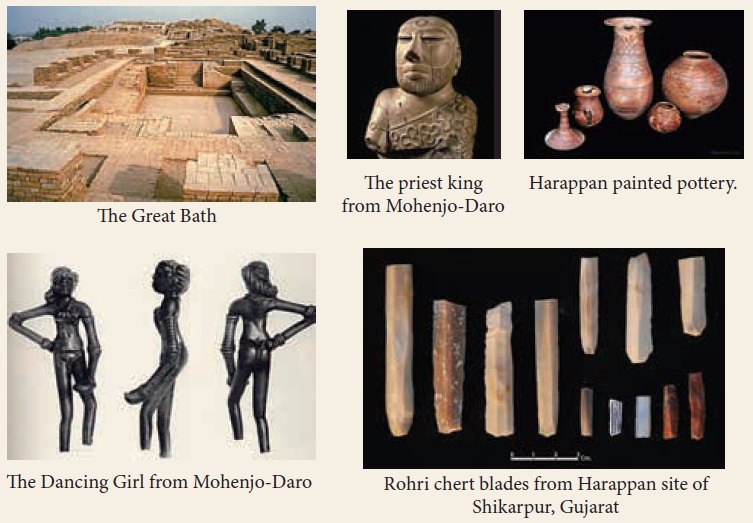
Rohri
chert refers to the chert raw material
collected from Rohri in Pakistan. It was used by the Harappans for making
blades.The Harappans used both stone and bronze tools.
Textiles and Ornaments
The Harappans used metal and stone adornments. They
had knowledge of cotton and silk textiles. They made carnelian, copper and gold
ornaments. Faience, stoneware and shell bangles were also used. Some of them
had etched designs, and the Harappans exported them to the Mesopotamia.
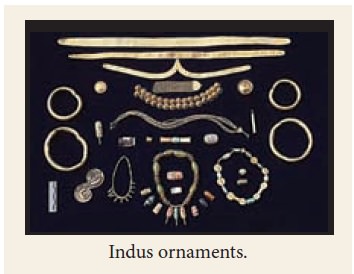
Trade and Exchange
The Harappans had close trade links with the Mesopotamians. Harappan seals have been found in the West Asian sites, Oman, Bahrain, Iraq and Iran. The cuneiform inscriptions mention the trade contacts between Mesopotamia and the Harappans. The mention of ‘Meluhha’ in the cuneiform inscriptions is considered to refer to the Indus region.
Weights and Measures
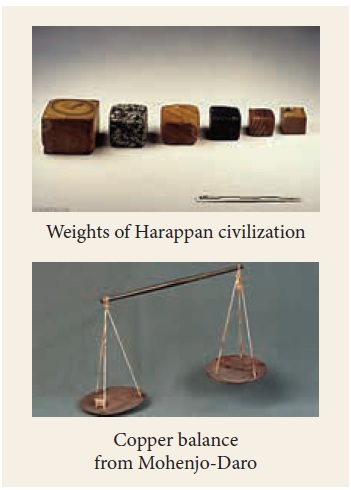
The Harappans developed a system of proper weights
and measures. Since they engaged in commercial transactions, they needed
standard measures. The cubical chert weights are found at the Harappan sites.
The copper plates for weighing balances have also been found.The weights point
to their knowledge of the binary system. The ratio of weighing is doubled as
1:2:4:8:16:32.
Seals, Sealings and Scripts
The seals from various media such as steatite,
copper, terracotta and ivory are found in the Harappan sites. They were
probably used in the trade activities. The Harappan script is not yet
deciphered. About 5,000 texts have been documented from the Harappan sites.
Some scholars are of the view that the script is in Dravidian language.
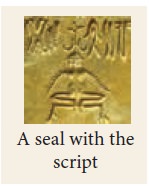
Arts and Amusement
The terracotta figurines, paintings on the pottery
and the bronze images from the Harappan sites suggest the artistic skills of
the Harappans. ‘Priest king’ made of steatite and dancing girl made of bronze
(both from Mohenjo-Daro) as well as stone sculptures from Harappa, Mohenjo-
Daro and Dholavira are the important objects of art. Toy carts, rattles,
wheels, tops, marbles and hop scotches made in terracotta suggest the amusement
of the Harappan people.
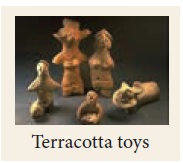
Religion
The
Indus people had
a close relationship[ with
nature. They worshipped pipal trees.
Some of the terracotta figures resemble the mother goddess. Fire altars have
been identified at Kalibangan. The Indus people buried the dead. Burials were
done elaborately and evidence for cremation has also been found.
Original Inhabitants and their Culture
The authors of the Harappan civilisation are not
known, since the script has not been deciphered. One school of thought argues
that they spoke the Dravidian language. The archaeological evidence shows
movement of the Harappans to the east and south after the decline of the Indus
civilisation. It is probable that some of the Harappan people moved into
different parts of India. Only the decipherment of the script can give a
definite answer.
Indus civilisation had more than one group of
people. Several groups including farmers, pastoralists and hunter-gatherers
lived in the Indus region. The Indus region had villages and large towns. The
population was mixed.
The period of the civilisation has been divided
into Early Harappan, starting around 3300 BCE and continuing to 2600 BCE and
mature Harappan, are the last phase civilisation from 2600 to 1900 BCE. The
later Harappan existed upto 1700 BCE.
Decline of Indus Culture
The Indus civilisation and its urban features
started declining from about 1900 BCE. Changes in climate, decline of the trade
with Mesopotamia and drying up or flooding of the river Indus, foreign invasion
were some of the reasons attributed to the collapse of this civilisation and
for the migration of people in the southern and eastern directions. It did not
completely disappear. It continued as rural culture.
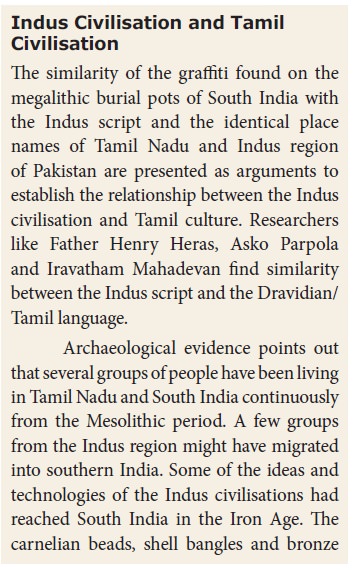

Related Topics